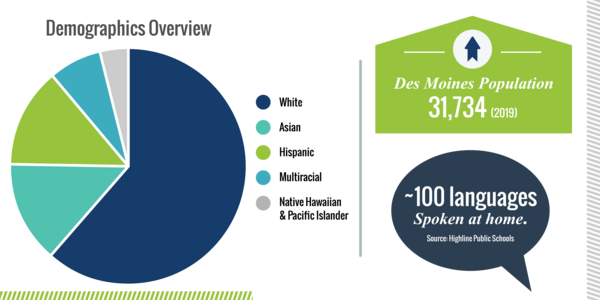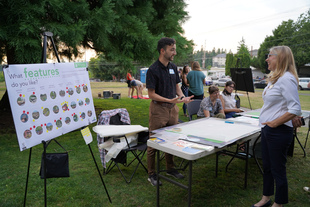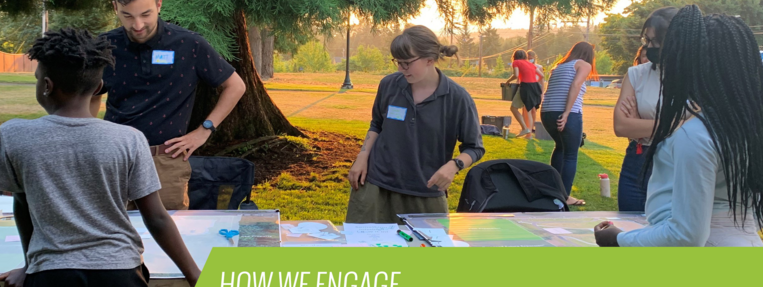How We Engage
Des Moines Parks, Recreation, and Senior Services Master Plan & Midway Park
The 2022 Des Moines Parks, Recreation, and Senior Services (PRSS) Master Plan provides an updated analysis of the City’s parks, recreation, and senior services facilities and programming to inform decision-making for future investments.
More than 500 Des Moines residents provided their input on community needs and priorities during the planning process. Outreach included multiple public open houses, tabling at the Waterfront Farmers Market, stakeholder interviews, and providing opportunities for online participation. A statistically valid community survey was administered by ETC Institute and was completed by 410 households.
 Community engagement was an essential part of the plan development and adoption process. During the summer and fall of 2021, the City engaged over 500 people in a dialogue about the future of Des Moines’ parks, recreation, and senior services. Opportunities for participation included two booths at the Des Moines Waterfront Farmer’s Market, three open houses held throughout the City, comments sent to the City via email, responses to a mailed community survey, and stakeholder interviews. City staff and the consultant team also virtually visited a kindergarten class at Midway Elementary to hear children’s ideas for their parks. Public involvement opportunities were also available throughout the adoption process at City Council meetings.
Community engagement was an essential part of the plan development and adoption process. During the summer and fall of 2021, the City engaged over 500 people in a dialogue about the future of Des Moines’ parks, recreation, and senior services. Opportunities for participation included two booths at the Des Moines Waterfront Farmer’s Market, three open houses held throughout the City, comments sent to the City via email, responses to a mailed community survey, and stakeholder interviews. City staff and the consultant team also virtually visited a kindergarten class at Midway Elementary to hear children’s ideas for their parks. Public involvement opportunities were also available throughout the adoption process at City Council meetings.

The PRSS Master Plan also included detailed planning for newly acquired park resources at Midway Park, Mary Gay Park, and Van Gasken Park. Our work included analyzing the City’s parks acreage and facilities against City-established level-of-service standard. The planning process found that there is still a need for additional investment in parks in Des Moines.
The PRSS Master Plan provides the City with direction for future investments to support its goal of continuing to provide robust and equitable parks, recreation, and senior services system. With input from the community and an updated analysis of the City’s parks inventory, the recommendations in this plan strive to fulfill resident needs and create a healthy, active Des Moines.
Completion Date: December 2021
Outstanding Features:
- Robust multi-lingual public engagement
- Design charette for newly acquired park resources
- Opinions of probable cost

Q: What was your role in the public engagement process?
Sarah Wallace (SW): The landscape architecture team worked alongside the planning team to develop materials for the Midway Park Open House. We provided hands-on activities for attendees to engage with site design and identify site opportunities and constraints for Midway Park.
Stefanie Hindmarch (SH): I worked with the AHBL planning team to interview stakeholders identified by Des Moines staff, prepared materials for open houses and farmers’ market booths, and facilitated engagement at events.
Q: Were virtual engagement strategies used for public outreach and engagement? If so, what channels were used (social media, project webpage, Zoom meetings, etc.)?
SH: Social media was used to notify the public about upcoming events. Our in-person open houses were also accompanied by digital surveys to ensure that those who could not attend were able to engage with the process.
Q: What public engagement tactics worked well? What was an outcome/result that helped inform the project?
SW (Midway Park): One of the activities we had at the Midway Park Open House was a printed-out aerial image of the site with scaled cutouts of potential site elements such as basketball courts, trees, bathrooms, etc. Many attendees were interested in this activity and found it to be an effective way to consider what activities and amenities they would like to have in the park and where they should be located.
SH: The community survey was a great tool that provided us with statistically valid data about community priorities and challenges. These findings, in addition to our conversations with residents and stakeholders, helped shape plan recommendations to meet community needs.
Q: What was a key “lesson learned” for the public engagement process? What could be improved in the future?
SH: We had strong engagement from attendees of all ages in the site design exercise; people were excited to visually express their ideas for the space. This would be a great tool to use again in the future.
Q: What was your favorite aspect of the public engagement process?
SW (Midway Park): I loved meeting the community members and having conversations about the future of Midway Park. A designer's greatest asset in the design process is input from existing site users and stakeholders!
SH: I especially enjoyed the Midway Park outreach event and hearing all the great ideas that local kids and teens shared with us. It was clear that Midway Park is a beloved space, and we were excited to help facilitate the park design process.
Q: What did you learn about the Des Moines community through the public engagement process?
SH: Our stakeholder interviews really brought to light some of the opportunities and challenges for parks and recreation in Des Moines. There was a particular emphasis on the need for programming for youth, especially teens.
